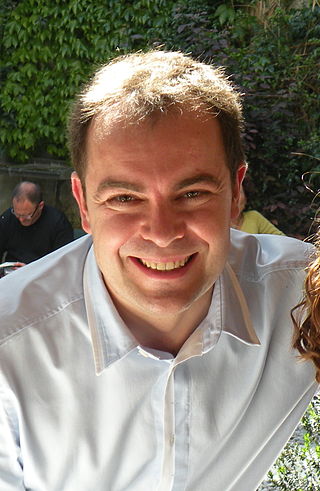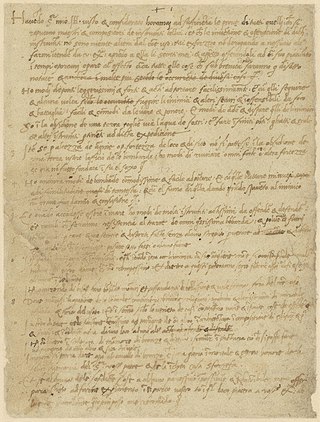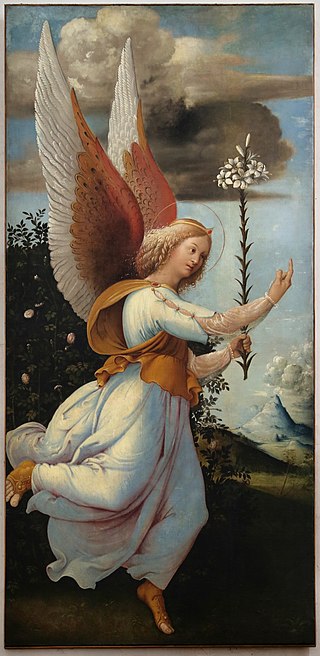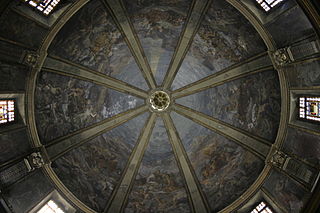Related Research Articles

Leonardo di ser Piero da Vinci was an Italian polymath of the High Renaissance who was active as a painter, draughtsman, engineer, scientist, theorist, sculptor, and architect. While his fame initially rested on his achievements as a painter, he has also become known for his notebooks, in which he made drawings and notes on a variety of subjects, including anatomy, astronomy, botany, cartography, painting, and palaeontology. Leonardo is widely regarded to have been a genius who epitomised the Renaissance humanist ideal, and his collective works comprise a contribution to later generations of artists matched only by that of his younger contemporary Michelangelo.

The Last Supper is a mural painting by the Italian High Renaissance artist Leonardo da Vinci, dated to c. 1495–1498, housed in the refectory of the Convent of Santa Maria delle Grazie in Milan, Italy. The painting represents the scene of the Last Supper of Jesus with the Twelve Apostles, as it is told in the Gospel of John – specifically the moment after Jesus announces that one of his apostles will betray him. Its handling of space, mastery of perspective, treatment of motion and complex display of human emotion has made it one of the Western world's most recognizable paintings and among Leonardo's most celebrated works. Some commentators consider it pivotal in inaugurating the transition into what is now termed the High Renaissance.

Il Sodoma was the name given to the Italian Renaissance painter Giovanni Antonio Bazzi. Il Sodoma painted in a manner that superimposed the High Renaissance style of early 16th-century Rome onto the traditions of the provincial Sienese school; he spent the bulk of his professional life in Siena, with two periods in Rome.

Santa Maria delle Grazie is a church and Dominican convent in Milan, northern Italy, and a UNESCO World Heritage Site. The convent contains the mural of The Last Supper by Leonardo da Vinci, which is in the refectory.

Francesco Melzi, or Francesco de Melzi (1491–1567), was an Italian painter born into a family of the Milanese nobility in Lombardy. He became a pupil of Leonardo da Vinci and remained as his closest friend and professional assistant throughout his career. After da Vinci’s death, Melzi became the literary executor of all da Vinci's papers and compiled them into a manuscript known as the Codex Urbinas. This compilation later served as the basis for the Trattato della Pittura, which was published posthumously by others based on Melzi’s organization of da Vinci’s notes.

Leonardo da Vinci was an Italian Renaissance painter and polymath who achieved legendary fame and iconic status within his own lifetime. His renown primarily rests upon his brilliant achievements as a painter, the Mona Lisa and The Last Supper, being two of the most famous artworks ever created, but also upon his diverse skills as a scientist and inventor, engineer, theorist, sculptor, and architect. He became so highly valued during his lifetime that the King of France bore him home like a trophy of war, supported him in his old age and, according to legend, cradled his head as he died.

Javier Sierra Albert is a journalist, writer and researcher who studied journalism at the Complutense University of Madrid.

The Battle of Anghiari (1505) is a painting by Leonardo da Vinci in the Salone dei Cinquecento in the Palazzo Vecchio, Florence. Its central scene would have depicted four men riding raging war horses engaged in a struggle for possession of a standard at the Battle of Anghiari in 1440.

Marco d'Oggiono was an Italian Renaissance painter and a chief pupil of Leonardo da Vinci, many of whose works he copied.

The Italian polymath Leonardo da Vinci (1452–1519) left thousands of pages of writings and drawings, but rarely made any references to his personal life. The resulting uncertainty, combined with mythologized anecdotes from his lifetime, has resulted in much speculation and interest in Leonardo's personal life. Particularly, personal relationships, philosophy, religion, vegetarianism, left-handedness and appearance.
Ross King is a Canadian novelist and non-fiction writer. He began his career by writing two works of historical fiction in the 1990s, later turning to non-fiction, and has since written several critically acclaimed and best-selling historical works.

Mario Taddei is an Italian academic. He is an expert in multimedia and edutainment for museums, a Leonardo da Vinci devotee and scholar, and an expert in the codexes and machines of da Vinci and ancient books of technology.

Fra Girolamo Bonsignori, was an Italian artist.

Giovanni Agostino da Lodi was an Italian painter who was active from c. 1495 to c. 1525.

The Italian Renaissance painter Domenico Ghirlandaio painted the Last Supper of Jesus three times in separate fresco paintings in or near Florence. The oldest of the three is located in the Badia di Passignano (1476). The next painting is the most famous one, painted in the refectory of the Convent of the Ognissanti (1480). The last painting is found at the Convent of San Marco (1486). The last two paintings are found in Florence itself.

Agostino Comerio was an Italian painter, active mainly in Northern Italy.

The Church of Our Lady of the Graces is a Gothic-style, Roman Catholic church in Varallo Sesia, province of Vercelli, region of Piedmont, Italy. The church was built, together with the adjacent Franciscan convent, by padre Bernardo Caimi between 1486 and 1493. At this time, the construction of the Sacro Monte was also beginning. In December 1931, Pope Pius XI gave the church the title of Minor Basilica.

Work on the conservation and restoration of Leonardo da Vinci's The Last Supper mural, much of it more harmful than helpful, has been carried out over many centuries, and continues. Completed in the late 15th century by the Renaissance artist Leonardo da Vinci, the mural is located in the refectory of the Convent of Santa Maria delle Grazie, Milan, Italy. The Last Supper was commissioned by Ludovico Sforza, Duke of Milan in 1495, as part of a series of renovations to the convent with the intention that the location would become the Sforza family mausoleum. Painting began in 1495 and continued until 1498.

Leonardo and the Last Supper, is a 2011 book written by Ross King, a Canadian novelist and non-fiction writer. He was awarded Canada's 2012 Governor General's Award for English-language non-fiction for Leonardo and the Last Supper, his examination of da Vinci's iconic 15th century religious mural.

Leonardo da Vinci's Vineyard is a vineyard the Duke of Milan, Ludovico Maria Sforza best known as Ludovico il Moro, gave as a gift to Leonardo da Vinci in 1498 while he was working on the painting of Last Supper in the nearby refectory of the cathedral and Dominican convent of Santa Maria delle Grazie. It was a gesture to give credit for the many admirable works Leonardo had been creating for the Duke.
References
- The Secret Supper, Javier Sierra, 2006 (Atria Books) ISBN 978-0-7432-8764-7
- La Cena Secreta, Javier Sierra, 2004 (Plaza & Janés) ISBN 84-672-1092-3